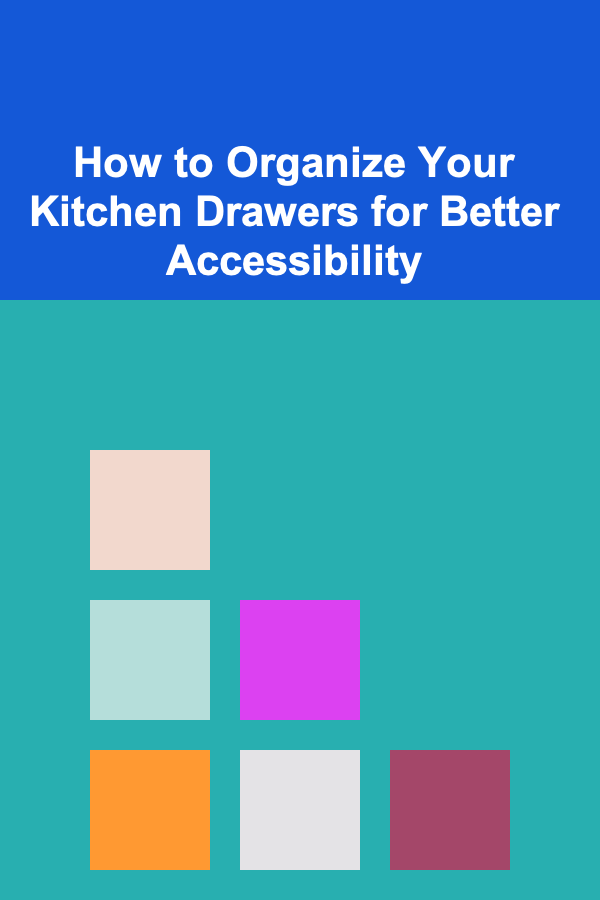
How to Organize Your Kitchen Drawers for Better Accessibility
ebook include PDF & Audio bundle (Micro Guide)
$12.99$11.99
Limited Time Offer! Order within the next:

A well-organized kitchen is essential for efficiency and ease of use, and the drawers play a crucial role in this. Kitchen drawers, in particular, can easily become cluttered with utensils, tools, and other items, making it difficult to find what you need when you need it. An organized kitchen drawer system will not only improve your kitchen's functionality but also streamline meal preparation, minimize stress, and enhance your overall cooking experience. This article provides a detailed, step-by-step guide to organizing your kitchen drawers for better accessibility.
Assessing Your Kitchen Needs
Before you begin organizing your kitchen drawers, the first step is to evaluate your space and understand your specific needs. Kitchen drawers come in various sizes, and each drawer can serve different functions. Whether you have a spacious kitchen or a small one, it's important to make sure your drawers meet your specific needs.
1.1 Identify Drawer Types
Kitchen drawers come in different depths, widths, and heights. Each drawer may have a unique purpose, such as storing utensils, cutlery, kitchen tools, or even spices. Here are the typical types of drawers you may encounter in a kitchen:
- Shallow drawers: Best suited for utensils, kitchen tools, and smaller items like measuring spoons or napkins.
- Deep drawers: Ideal for storing pots, pans, baking sheets, and larger items.
- Divided drawers: These are designed to be divided into compartments to help organize smaller items such as utensils, knives, or spices.
- Pull-out trays: Often used to store items like spices, canned goods, or cleaning supplies.
Identifying these types of drawers in your kitchen will help you determine where different items should be placed for easy access.
1.2 Identify Items to Store
Once you've assessed your drawers, take a moment to evaluate the items you need to store. This step is essential for making sure each drawer serves its purpose effectively. Common kitchen drawer items include:
- Cutlery (e.g., knives, forks, spoons)
- Cooking utensils (e.g., spatulas, tongs, wooden spoons)
- Measuring tools (e.g., measuring cups, spoons, scales)
- Gadgets and tools (e.g., can openers, peelers, graters)
- Spices and seasonings
- Cloths and napkins
- Small appliances (e.g., blenders, mixers, food processors)
Consider how often you use each item. Regularly used items should be placed in easily accessible drawers, while infrequently used items can be placed in less accessible areas or higher drawers.
Decluttering Your Drawers
Before diving into organizing, it's important to declutter. Over time, kitchen drawers tend to accumulate items that are no longer needed, making it difficult to find what you want. Decluttering is a crucial part of organizing your kitchen drawers for better accessibility.
2.1 Empty Out the Drawers
Start by taking everything out of your kitchen drawers. Lay out all the items on your countertop or table. This will allow you to see what you're working with and make it easier to determine what needs to stay and what can go.
2.2 Sort and Purge Unnecessary Items
Go through each item carefully. Ask yourself questions such as:
- Do I use this regularly?
- Is this broken or outdated?
- Do I have duplicates?
If an item doesn't serve a purpose, is broken, or you haven't used it in months, it's time to let it go. Donate or dispose of items that no longer add value to your kitchen.
2.3 Clean the Drawers
Once the drawers are empty, take the opportunity to clean them thoroughly. Use mild soap and water, or a gentle cleaner to wipe down the inside of each drawer. This ensures that when you replace your items, the drawers will be fresh and ready for the new organization system.
Categorizing Your Kitchen Items
An important part of organizing your drawers is categorizing the items. By grouping similar items together, you will make your kitchen drawers more efficient and accessible.
3.1 Group Similar Items
Once your drawers are cleaned and decluttered, begin grouping items by category. Here are some common groupings:
- Utensils: Forks, knives, spoons, and other flatware.
- Cooking tools: Whisks, spatulas, tongs, etc.
- Baking tools: Rolling pins, pastry cutters, cookie cutters, etc.
- Measuring tools: Measuring cups, spoons, scales, etc.
- Spices and seasonings: Salt, pepper, herbs, etc.
- Cleaning supplies: Dish soap, sponges, cleaning rags.
This categorization will allow you to prioritize what should be within easy reach and what can be stored further away. For example, you likely want your most frequently used items, like knives, forks, and teaspoons, easily accessible in the top drawer. In contrast, baking tools and specialized kitchen gadgets might go in a lower or deeper drawer, as these are used less frequently.
3.2 Prioritize Accessibility
It's essential to prioritize which items should be easily accessible. Think about your daily kitchen habits. Place frequently used items, such as cutlery, knives, or utensils, in drawers you access most often. Place less commonly used items in drawers that are further away. For instance, if you bake often, having baking tools within arm's reach can make your cooking process more efficient.
Organizing Your Kitchen Drawers
Now that you've decluttered and categorized your kitchen items, it's time to start the organizing process. To optimize accessibility and ensure your kitchen drawers are both functional and aesthetically pleasing, use the following strategies.
4.1 Use Drawer Dividers
Drawer dividers are an excellent solution to separate and organize smaller items, such as utensils, measuring spoons, and gadgets. Dividers come in various forms, including:
- Adjustable dividers: These allow you to customize the drawer compartments based on your needs.
- Fixed dividers: These offer a more rigid structure and are great for items that fit into specific compartments, such as silverware.
- Plastic or bamboo dividers: These are easy to clean, lightweight, and come in multiple configurations.
4.2 Consider Drawer Trays for Flatware
A drawer tray is an essential organizing tool for flatware and utensils. These trays are designed to separate spoons, forks, and knives into designated slots, ensuring easy access and preventing them from jumbling together. Choose a tray that fits snugly within your drawer, keeping everything in its place.
4.3 Use Inserts for Small Items
For smaller kitchen gadgets or tools, such as can openers, bottle openers, or measuring spoons, drawer inserts can help you keep everything neatly organized. These inserts come in various shapes and sizes, depending on what you need to store. Inserts will also help prevent smaller items from getting lost or buried underneath larger tools.
4.4 Utilize Pull-Out Drawers for Deeper Storage
If you have deep drawers, consider installing pull-out drawers or organizers. These will allow you to fully access the contents at the back of the drawer, making it easier to retrieve items. Pull-out organizers can be particularly useful for storing pots, pans, or baking sheets.
4.5 Label the Drawers
Labeling your drawers is a simple but effective way to improve accessibility. Using clear labels on each drawer or compartment ensures that everyone in the household knows where to find items and where to return them. Labels are particularly useful for multi-user kitchens, ensuring that everyone follows the same organization system.
4.6 Store Similar Items Together
If you have a collection of kitchen tools that perform similar functions, consider grouping them together. For example, store all your measuring spoons and cups in one drawer or all your spatulas and tongs in another. This makes it easier to find the tool you need and keeps your drawers organized.
Maintain Your Organized Kitchen Drawers
After you've spent time organizing your kitchen drawers, it's essential to maintain the system. Keeping drawers tidy over time ensures that they continue to serve their purpose and stay organized.
5.1 Regularly Reassess Your Organization System
Life changes, and so do your kitchen habits. Over time, your cooking needs and the items you use might change. Therefore, it's a good idea to reassess your organization system every few months. Ensure that the items you use most frequently are still easily accessible, and make adjustments if necessary.
5.2 Avoid Drawer Overflow
Avoid overstuffing your drawers. When drawers become too full, it becomes difficult to find what you need, and the items can become damaged. Periodically check that each drawer has enough space to comfortably accommodate the items it holds.
5.3 Clean and Reorganize Regularly
A clean, well-maintained kitchen is more likely to remain organized. Regularly wipe down your drawers and remove any crumbs, spills, or dust. Doing so will not only keep your kitchen drawers looking tidy but also extend the lifespan of your kitchen tools and utensils.
Conclusion
Organizing your kitchen drawers for better accessibility is a game-changer. With the right planning, categorization, and tools, your kitchen drawers can be transformed into efficient, accessible spaces that make meal prep and cooking a breeze. Start by assessing your kitchen's needs, decluttering your drawers, and organizing your items by category. Make use of dividers, inserts, and pull-out trays to keep things neat, and label your drawers for easy identification. With these tips, you'll create a well-organized kitchen that promotes efficiency, reduces stress, and maximizes your culinary potential.
Reading More From Our Other Websites
- [Personal Care Tips 101] How to Meal Prep for Healthy Breakfasts
- [Skydiving Tip 101] DIY Maintenance Tips to Keep Your skydiving helmet in Peak Condition
- [Home Party Planning 101] How to Plan a Wine & Cheese Pairing Party?
- [Organization Tip 101] Why Seasonal Decluttering is Important for Space
- [Biking 101] Top 5 Trail Bikes for Different Terrain and Riding Styles
- [Home Space Saving 101] How to Design a Compact and Functional Small Bathroom
- [Personal Financial Planning 101] How to Achieve Your Financial Goals with Small Daily Changes
- [Organization Tip 101] Why You Should Use Drawer Organizers for Kitchen Utensils
- [Home Storage Solution 101] How to Keep Your Kids' Art Supplies Organized and Accessible
- [Small Business 101] Best Customer Loyalty Programs Tailored to Small Fitness Studios

How to Create a Checklist for Evaluating the Financial Stability of Potential Partners
Read More
How to Make Your Home's Entryways More Secure
Read More
Why A Well-Organized Entryway Reduces Clutter in the Home
Read More
Why You Should Create a Digital Backup for Important Documents
Read More
How to Find Exciting Surf Spots
Read More
How to Build a Rustic Pallet Coffee Table
Read MoreOther Products

How to Create a Checklist for Evaluating the Financial Stability of Potential Partners
Read More
How to Make Your Home's Entryways More Secure
Read More
Why A Well-Organized Entryway Reduces Clutter in the Home
Read More
Why You Should Create a Digital Backup for Important Documents
Read More
How to Find Exciting Surf Spots
Read More